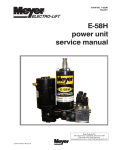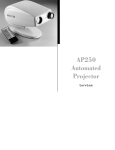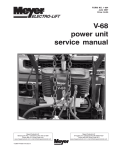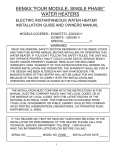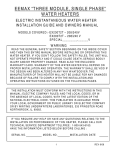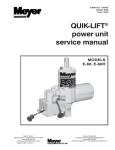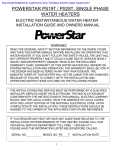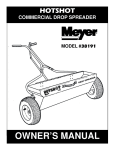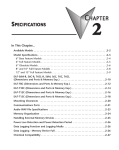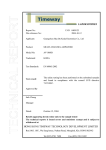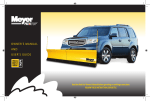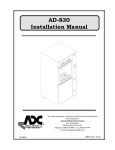Download E-72 power unit service manual
Transcript
FORM NO. 1-1047 January 2012 E-72 power unit service manual Meyer Products LLC 18513 Euclid Ave. • Cleveland, Ohio 44112-1084 Phone 486-1313 (Area Code 216) www.meyerproducts.com• email [email protected] © 2012 Printed in the U.S.A. FOREWARD This Service Manual includes complete information for servicing the following Electro Lift® Units: E-72 IMPORTANT: Maintenance and repairs must be performed with the moldboard on the ground. The information is grouped according to the type of work being performed, such as diagnosis and testing, disassembly and reassembly. Special tools and specifications are also included in this manual. All information, illustrations and product descriptions contained in this manual are correct at publication time. We do, however, reserve the right to make changes at any time without prior notice. MEYER PRODUCTS INC. SECTION INDEX Section Number Section Title ..................................................... 0 GENERAL INFORMATION AND MAINTENANCE ........................................................ GENERAL DESCRIPTION AND THEORY OF OPERATION ........................................ DIAGNOSIS ............................................................. REPAIR PROCEDURE .............................................. CONTROLLER TROUBLESHOOTING .................... SPECIFICATIONS ..................................................... 1 2 3 4 5 Page 1 4 14 20 43 44 Meyer Products Inc. reserves the right, under its continuing product improvement program, to change construction or design details, specifications and prices without notice or without incurring any obligation. SECTION 0 - GENERAL INFORMATION AND MAINTENANCE CONTENTS GENERAL INFORMATION .................................................. 2 • MODEL IDENTIFICATION .................................................... 2 • MODEL IDENTIFICATION AND SERIAL NUMBER LOCATION .............................................. 2 • MOTOR IDENTIFICATION ................................................... 2 MAINTENANCE ................................................................... 2 • GENERAL MAINTENANCE ................................................... 2 • CLEANLINESS ................................................................. 2 • VEHICLE ELECTRICAL SYSTEM ........................................... 2 • CHECK REGULARLY ........................................................ 2 POST-SEASON MAINTENANCE ........................................... 2 • MEYER HYDRAULIC FLUID M-1 ......................................... 2 • REPLACEMENT OF HYDRAULIC FLUID ................................... 3 • FILTERS ........................................................................ 3 PROTECTION AGAINST RUST CORROSION ............................................................ 3 • AND -1- GENERAL INFORMATION Model Identification The E-72 unit is an electrically powered hydraulic mechanism specifically designed for use with the Meyer E-Z Mount Plus and Drive Pro Snow Plow systems. MAINTENANCE The following maintenance information is intended as a basic guide for providing the E-72 unit with the proper service and care. Sustained heavy duty operation or operating under adverse conditions may necessitate more frequent servicing. Model Identification and Serial Number Location Inclusion of the model number and serial number is extremely important when writing up warranty claim forms and product report forms for proper evaluation and follow up. General Maintenance Cleanliness The greatest enemy to any hydraulic system is dirt or contamination. Therefore, cleanliness must be stressed at the time of installation, servicing and repairing. The basic model number is located on the name plate (plastic cover). The serial number is located on the name plate decal underneath the plastic cover. Vehicle Electrical System Maximum performance and efficiency of the Electro Lift® unit requires that the vehicle’s electrical system be properly maintained and consist of: Battery ----------Alternator ------ 70 Amp. Hr. Minimum or 550 Cold Cranking Amps. 60 Amp. Minimum Check Regularly 1. Battery Terminals - Must be clean and free of corrosion. 2. Electrical Connections - Must be free of corrosion and tight. 3. Battery - Must be in first-class condition. 4. Alternator (or Generator) and Regulator - Must be functioning to specifications. 5. Hydraulic Fluid Reservoir Level - A significant drop in hydraulic fluid level indicates a leak which must be located and corrected. Insufficient hydraulic fluid may result in severe damage. POST-SEASON MAINTENANCE Meyer Hydraulic Fluid M-1. Meyer Hydraulic Fluid M-1 is a specially formulated mineral oil which maintains an almost constant viscosity from normal to sub-zero temperatures. Because it remains free flowing at extremely low temperatures, the performance and efficiency are not affected. Meyer Hydraulic Fluid M-1 also contains an additive which neutralizes moisture accumulating in the fluid due to condensation. It is effective for a maximum of one year’s use. Meyer Products Inc. will not be liable for damages resulting from the use of inferior or other fluids or oils. -2- FIGURE 0-1 Replacement of Hydraulic Fluid After a season’s use, completely drain the hydraulic fluid (including hydraulic fluid in hoses and cylinders). Drain fluid through drain plug shown in Figure 0-1. Disconnect the fittings at the Angling and Lift cylinders and completely retract the cylinder rods and purge cylinders and hoses of all hydraulic fluid. Flush the complete system including unit, hoses and angling rams with the M-2 Flushing Fluid, or a non wax (Napthenic) cleaner. If kerosene (Parrafinic) is used to flush the system, the system must be flushed again to remove any kerosene with M-2 Flushing Fluid, or a (Napthenic) based cleaner that is wax free. Refill E-72 unit with M-1 Fluid by fully retracting lift rod (Ram) and filling reservoir to the fill mark on the side of the reservoir. Fill and bleed hoses and Power Angling cylinders by loosening hydraulic fittings at cylinders until they leak. Power angle plow repeatedly from one side to the other until fluid flows steadily from the leaking fittings while maintaining a constant check on the reservoir fluid level. Raise and lower the plow several times and with lift rod fully retracted, give a final check to the fluid level and replace filler plug. Filler Plug Protection Against Rust and Corrosion When the E-72 unit is not used for extended periods, protect the chromed lift rod (Ram) by fully extending it and coating it with chassis lubricant. Full extension of the lift rod (Ram) fills the cylinder with hydraulic fluid. Coat the exposed portions of the Power Angling cylinder rods (Rams) with chassis lubricant to protect them against rust and corrosion. Drain Plug -3- SECTION 1 - GENERAL DESCRIPTION AND THEORY OF OPERATION CONTENTS GENERAL DESCRIPTION ................................................................................................. 5 THEORY OF OPERATION ................................................................................................. 5 • FUNCTIONS .................................................................................................................. 5 • ELECTRICAL AND FLOW CHARTS ...................................................................................... 6-9 ELECTRO LIFT® UNIT COMPONENTS ......................................................................... 9 MOTORS ...................................................................................................................... 9 •• Iskra .................................................................................................................... 9 • HYDRAULIC PUMP .......................................................................................................... 9 • PRESSURE RELIEF VALVE ................................................................................................ 9 • SOLENOID VALVES ......................................................................................................... 9-10 • •• Cartridge ............................................................................................................ 9-10 •• Coil ...................................................................................................................... 9-10 “A” Solenoid Valve ............................................................................................. 11 “B” Solenoid Valve ............................................................................................ 11 “C” Solenoid Valve ........................................................................................... 11 • CHECK VALVES .............................................................................................................. 11 • PILOT CHECK VALVE ...................................................................................................... 11 • CROSSOVER RELIEF VALVES ............................................................................................ 12 • SOLENOID SWITCH ........................................................................................................ 12 • FILTERS ....................................................................................................................... 12 -4- GENERAL DESCRIPTION E-72 unit is an electrically powered and electrically controlled hydraulic mechanism specifically designed for use with Meyer Snow Plows. The E-72 raises and lowers the plow with a remote 8" stroke hydraulic lift cylinder. In addition to raising and lowering the plow hydraulically, the E-72 angles the plow hydraulically, left and right, via remote hydraulic cylinders. The Electro Lift® unit consists of a specially designed high torque 12-volt DC motor which is directly coupled to a gear-type hydraulic pump. The pump obtains its supply of hydraulic fluid from an integral reservoir which totally surrounds the integral hydraulic cylinder which raises and lowers the plow. The E-72 includes an integral valve body which contains three electrically controlled solenoid valve cartridges. Solenoid valve cartridge “A” which is energized to allow the plow to lower by gravity. Solenoid valve cartridge “B” is energized to route the pressurized hydraulic fluid to the remote hydraulic lift cylinder to raise the plow. Solenoid valve cartridge “C” is energized to route the pressurized hydraulic fluid to the left remote hydraulic cylinder to angle the plow to the right. When all cartridge are not energized and the motor is running the pressurized hydraulic fluid will flow to the right remote hydraulic cylinder to angle the plow to the left. Additional components which control and supply electrical current to the E-72 units are an operator controlled Pistol Grip controller; a solenoid switch to supply high amperage current to the unit’s motor (motor solenoid); valve cartridge(s); and short heavy gauge cables to distribute high amperage current directly from the positive terminal of the vehicle’s battery and ground the unit directly to the negative terminal of the vehicle’s battery. THEORY OF OPERATION FUNCTIONS Refer to Figures 1-1 through 1-4 (pages 6 thru 9) for electrical and hydraulic flow chart for each function. Each figure explains which component is actuated and related in each function. The E-72 four basic functions performed are: • Raise snow plow • Lower snow plow • Angle snow plow to right • Angle snow plow to left -5- FIGURE 1-1 -6- Reservoir STRAINER PUMP RAISE LIFT CYLINDER PRESSURE RELIEF VALVE ADJUSTABLE OPENS at 2000 + 50 P.S.I. PUMP CHECK VALVE RETURN TO RESERVOIR A LOWER ADJUSTMENT NOT ENERGIZED B ENERGIZED C DUAL PILOT CHECK NOT ENERGIZED POWER ANGLING CYLINDERS POWER ANGLING CYLINDERS CROSS-OVER RELIEF VALVE 3800 + 400 P.S.I. E-72 Raise, Motor and “B” Solenoid FIGURE 1-2 -7- Reservoir STRAINER PUMP LOWER LIFT CYLINDER PRESSURE RELIEF VALVE ADJUSTABLE OPENS at 2000 + 50 P.S.I. PUMP CHECK VALVE RETURN TO RESERVOIR A LOWER ADJUSTMENT ENERGIZED B NOT ENERGIZED C DUAL PILOT CHECK NOT ENERGIZED E-72 Lower, “A” Solenoid POWER ANGLING CYLINDERS CROSS-OVER RELIEF VALVE 3800 + 400 P.S.I. POWER ANGLING CYLINDERS -8- Reservoir STRAINER PUMP LIFT CYLINDER ANGLE LEFT FIGURE 1-3 PRESSURE RELIEF VALVE ADJUSTABLE OPENS at 2000 + 50 P.S.I. PUMP CHECK VALVE RETURN TO RESERVOIR A LOWER ADJUSTMENT NOT ENERGIZED B NOT ENERGIZED C DUAL PILOT CHECK NOT ENERGIZED E-72 Angle Left, Motor only POWER ANGLING CYLINDERS CROSS-OVER RELIEF VALVE 3800 + 400 P.S.I. POWER ANGLING CYLINDERS -9- Reservoir STRAINER PUMP LIFT CYLINDER PRESSURE RELIEF VALVE NON ADJUSTABLE OPENS at 2000 + 50 P.S.I. PUMP CHECK VALVE RETURN TO RESERVOIR A LOWER ADJUSTMENT NOT ENERGIZED B NOT ENERGIZED C DUAL PILOT CHECK ENERGIZED POWER ANGLING CYLINDERS POWER ANGLING CYLINDERS CROSS-OVER RELIEF VALVE 3800 + 400 P.S.I. E-72 Angle Right, Motor and “C” Solenoid ANGLE RIGHT FIGURE 1-4 ELECTRO LIFT® UNIT COMPONENTS E-72 UNIT COMPONENTS direction by the valve spring, the poppet valve will open. This allows some of the pressurized hydraulic fluid to flow through the connecting passage to the non pressurized inlet passage. The effect is to lower the pressure in the outlet passage which will allow the valve spring to close the poppet valve again. MOTOR (4-1/2”) Monarch - Two terminal The Monarch motor is a four pole, electromagnet motor which consists primarily of a 4-1/2" diameter solid steel frame, armature, brushes, field coils and pole pieces. This motor can be used on vehicles with either the common negative ground electrical system or the positive ground electrical system. OUTLET PORT POPPET VALVE VALVE SPRING HYDRAULIC PUMP PUMP HOUSING The pump in a hydraulic system employs an external source of power to apply a force to a liquid. A pump develops no power of its own. It simply transfers power from an external source (the electric motor on the E-72) to the liquid in the hydraulic system. INLET PORT FIGURE 1-6 The basic operating principles of the hydraulic pump used in the E-72 units are quite simple. Figure 1-5 illustrates the basic components of a positive displacement gear type pump and their functions. The pumping action takes place within the pump chamber which is connected to the reservoir by the intake line. The pump chamber has an outlet line in which the liquid under motion and pressure leaves the pump to perform work. Under a condition, such as when a hydraulic cylinder is extended to the end of its stroke, eliminating additional space for the pressurized hydraulic oil to be pumped into, the alternate opening and closing of the poppet valve controls the pump’s pressure output and provides an escape for the pressurized hydraulic fluid. The pressure relief valve used in the E-72 hydraulic unit, while more sophisticated than the one described, functions in the same manner. The pump pressure relief valve may be adjusted to the specified pressure of 2000 P.S.I. by adjusting the set screw after installing a suitable pressure gauge of 2500 P.S.I. in the circuit. RESERVOIR SOLENOID VALVES Hydraulic valves are simple in concept and all have the same basic function: Control the direction of oil flow. ELECTRIC MOTOR O FL W INTAKE LINE DRIVEN GEAR W O FL PUMP CHAMBER Each Solenoid Valve consists of two components: the Cartridge and the Coil. DRIVE GEAR Cartridge OUTLET LINE The Cartridge consists of the hydraulic valve mechanism and an armature which enables the valve mechanism to be operated and controlled electrically. The Cartridge is designed to screw in and out of the E-72 units much like the typical “spark plug”. PUMP HOUSING FIGURE 1-5 PRESSURE RELIEF VALVE A basic pressure relief valve is shown in Figure 1-6. It consists of a poppet valve and a valve spring. Both are located in a passage which connects the inlet passage to the outlet passage. The poppet valve is normally held closed by the valve spring, sealing the connecting passage from the pressurized outlet passage. The poppet valve, being a piston, is exposed to the pressurized hydraulic fluid in the outlet passage. Whenever the hydraulic pressure against the poppet valve becomes greater than the pressure being exerted on the poppet valve from the opposite Coil WINDING COIL VALVE SPOOL ARMATURE -10- FIGURE 1-7 ELECTRO LIFT® UNIT COMPONENTS CONT. The Coil is the electrical component which operates the Cartridge’s valve mechanism by producing magnetism which pulls the Cartridge’s armature toward it. Since the armature is connected to the valve mechanism’s only moving part, it is pulled by the armature. “C” Solenoid Valve E-72 The “C” Solenoid valve is used on the E-72 hydraulic unit for power angling. The “C” Cartridge contains a spool valve whose static (de-energized) position allows the pressurized hydraulic fluid to flow to the right power angling cylinder which angles the plow to the left. At the same time, it allows the hydraulic fluid being forced from the retracting left power angling cylinder to flow through the “C” Cartridge back to the reservoir. Figure 1-7 illustrates the typical Coil. Whenever electrical current flows to the Coil, it flows through the winding, which consists of numerous turns of copper wire. The flow of current through the winding produces a magnetic field which pulls the soft iron armature further into the Coil. In the energized position, the pressurized hydraulic fluid is diverted to the left power angling cylinder, angling the plow to the right. Also, the hydraulic fluid being forced from the retracting right power angling cylinder flows through the “C” Cartridge back to the reservoir. The armature pulls the valve spool or poppet valve into its alternate (energized) position. Not illustrated is an integral coil spring, which is compressed when the armature is pulled by the magnetism. CHECK VALVES Check valves are very simple devices that have two basic functions: They prevent fluid from passing through them in one direction, but they allow fluid to pass through them in the opposite direction. When the current flow ceases, the magnetic field disappears and the compressed coil spring pushes the armature back to its original (de-energized) position. In the E-72 a pump check valve is used to prevent hydraulic fluid from leaking back through the pump to the reservoir. “A” Solenoid Valve E-72 The “A” Cartridge contains a poppet valve whose static or de-energized position is closed. Its energized position is open. The E-72 unit uses one check valve located between the “B” Solenoid Valve and the lift cylinder. It prevents the hydraulic fluid in the lift cylinder from leaking back through the “B” Solenoid Valve which could cause the plow to drift down. The “A” Solenoid Valve retains hydraulic fluid in the lift cylinder. It is energized (opened) to allow the hydraulic fluid to flow from the lift cylinder back to the reservoir, enabling the plow to lower by gravity. DOUBLE ACTING PILOT CHECK VALVE The “A” Solenoid Valve is designed to remain energized (open) while the plow is lowered, plowing snow. This is the “float” feature which insures that the plow maintains contact with the ground contour. The pilot check valve is more sophisticated in that it incorporates a piston in addition to the ball, seat and spring. It is located next to the “C” valve on the E-72. It has two functions: The first is to prevent the hydraulic fluid in either power angling cylinder from leaking back to the reservoir. The second is to allow the hydraulic fluid from the retracting power angling cylinder during the angling cycle to return to the reservoir. This is accomplished by the pressurized hydraulic fluid moving the piston which forces the check ball off its seat. “B” Solenoid Valve E-72 The “B” Cartridge contains a poppet valve whose static or de-energized position is closed. Its energized position is open. The “B” Cartridge contains a spool valve whose (energized) position allows the pressurized hydraulic fluid to flow to the lift cylinder, raising the plow. The “B” Cartridge de-energized position retains the hydraulic fluid in the lift cylinder, holding the plow up. -11- ELECTRO LIFT® UNIT COMPONENTS CONT. CROSSOVER RELIEF VALVE With this system, the hydraulic fluid is filtered as it leaves the reservoir on its way to the pump and on the Power Angling units. When plowing snow, a snow plow can be exposed to damaging forces caused by impact with hidden obstructions, ends of curbs, etc. With power angling, these damaging forces can damage not only the snow plow but also the vehicle. The crossover relief valve has the function of protecting the snow plow system against these damaging forces under normal snow plowing conditions. The crossover relief valve, cannot protect the system from damaging forces that are too great due to abusive snow plowing conditions. IMPORTANT: Should the hydraulic fluid become contaminated, it will be necessary to replace all the hydraulic oil in the system. The complete system (hydraulic unit, power angling cylinders, mount cylinder and hoses) should be flushed. Flush the system with Meyer Hydra-Flush™ Fluid M-2. Basically, the crossover relief valve functions exactly like the previously described pump relief valve. It’s designed to open at a specific pressure. In this instance, the pressure is not produced by the pump but rather by the damaging force. As an example, assume that the right corner of the plow runs into the end of a curb. The impact will attempt to collapse the right power angling cylinder. As a result, very high hydraulic pressure is produced within the cylinder. When the produced pressure is high enough, it opens the crossover relief valve, allowing the highly pressurized hydraulic fluid to flow directly to the left power angling cylinder. When the crossover relief valve functions in this manner, the excessive pressure is released, the excessive energy produced by the impact is absorbed, and the result is only a change in angled position of the plow. The crossover relief valve is factory set to the specified pressure of 3000 P.S.I. this setting is adjustable. SOLENOID SWITCH The E-72 motor requires more current or amperage to operate than the vehicle wiring, vehicle ignition switch or toggle switches have the capacity to handle. The solenoid switch is essentially a heavy duty switch with the capacity to handle the heavy current required by the motor. It is closed electrically by the solenoid to convey the heavy current directly from the vehicle battery via heavy gauge electrical cable. The solenoid, which functions essentially the same as the previously described solenoid valves, receives its low amperage current at the proper times via the wiring harness. This solenoid must be grounded to operate properly. STRAINER Cleanliness is perhaps the single most important ingredient in assuring a hydraulic system’s reliability. Should the hydraulic fluid become contaminated, malfunction and permanent damage to the hydraulic system may occur. For this reason, all the E-72 units are equipped with a Strainer on the pump pick up tube. -12- SECTION 2 - DIAGNOSIS CONTENTS E-72 GENERAL INFORMATION 14 TESTING TIPS 14 “RAISE” Troubleshooting 15 “LEAK DOWN” Troubleshooting 16 “LOWER” Troubleshooting 16 “ANGLE LEFT” Troubleshooting 17 “ANGLE RIGHT” Troubleshooting 18 “WILL NOT HOLD ANGLE” Troubleshooting 18 Wiring Information 19 -13- DIAGNOSTIC FLOW CHART FOR E-72 Unit These charts are intended to be used as an aid in diagnosing problems on the E-72 unit. They are not a substitute for factory training and experience. Be certain to read the General Information and Testing Tips sections before attempting any troubleshooting. IMPORTANT: Maintenance and repairs must be performed with the moldboard on the ground. General Information 1. 2. 3. Before any troubleshooting is started, make certain the following conditions are met. The moldboard is pointing straight ahead. This can often be done by coupling the left cylinder into the right cylinder and pushing the moldboard by hand. The power angling cylinders must be installed correctly on to the plow assembly. The left cylinder (Driver’s side) has a hose attached with a female half of a coupler at the end; the right cylinder (Passenger side) has a hose attached with a male half of a coupler at the end. The solenoid wires must be on their proper coil. The “A” coil (black and tan wires) on power angling block labeled “BLK”. The “B” coil (red and tan wires) on power angling block labeled “RED”. The “C” coil (green and tan wires) on power angling block labeled “GRN”. TESTING TIPS Many tests do not require removing the Electro Lift® unit from the vehicle. However, more thorough testing can be performed using the Meyer Test Stand which allows direct pressure and amperage readings. 1. Using a screwdriver or other small tool to check for magnetism of the solenoid coils “A”, “B” and “C”. Place the tool on the nut securing the coil and have an assistant operate the switch. You should feel strong magnetic attraction. 2. Use a test light or volt meter to determine whether there is power at the harness. 3. When determining AMP draw of the motor, always obtain the highest value possible, i.e, at maximum raise or maximum angle with motor running. 4. The pump shaft of a good pump can be turned smoothly using two fingers. If it can’t be turn easily, the pump is too tight and must be replaced. 5. Pump pressure can be measured at an angle hose (note pressure at full angle). 6. Flush the complete system including unit, hoses and power angling rams with Meyer Hydra-Flush™ Fluid M-2. The controller is self diagnosing. The monitor light is located in the upper left corner next to the float light of the control switch. When the monitor light turns on and begins to flash the control switch is sensing a problem with a specific coil/connection on the hydraulic unit. The label below is on the back side of your control switch. Reset is accomplished by turning off the ignition switch or by turning the power switch off momentarily and then back on. If the monitor light is still illuminated after attempts to reset the switch have failed, contact your nearest authorized Meyer Distributor for repairs. -14- E-72 SNOW PLOW WILL NOT RAISE NO Does the Motor Operate? Is there power going to the motor? Are all electrical connections clean and tight? Is Battery Charged? NO YES Charge Battery Clean and tighten all electrical Connections. YES Remove motor. Does motor run when 12 volts is applied? NO Inspect Motor Armature, Brushes Repair or Replace Motor as necessary NO YES YES NO Can the pump shaft turn by hand? NO YES Is Ground Cable attached to the Negative (-) Battery Terminal? Is there power leaving the switch? Check switch for Continuity NO Is there power going to the motor solenoid, at White Wire? Check Wires at Molded connector. YES YES Replace the Wiring Harness. Replace the Motor Solenoid. YES NO Is the Fuse OK? NO YES Replace pump. Replace the Is the fluid level 1-1/2" below filler hole? NO Controller ADD M-1 Fluid YES Does the snow plow angle to the left instead of raising? NO Does the snow plow angle when the Angle Switch is activated? NO Is there pressure (or flow) at the raise port? NO Replace the Pump. YES YES Is the "A" Valve stuck in the open position? YES YES Clean or Replace "A" Valve. -Retest Does snow plow raise? NO Can pump relief pressure be adjusted to 2000 P.S.I. Is the pump shaft turning tightly? NO Does the motor armature turn tightly? YES YES Replace the Pump. NO Does the "B" Coil (Red Wire) have magnetism? NO NO Replace O-Rings. Is there power leaving the switch at the red wire? YES YES YES Are the "B" Valve O-Rings in good Condition? Is there power to the "B" Coil? (Red Wire) at Harness Replace the wiring harness. Replace "B" Coil. YES Clean or Replace the "B" Valve and retest. -15- NO Repair or Replace the motor. Are wires in molded connector making contact with the switch? YES Replace Controller Replace Fuse. Check for short in Harness, "B" Coil, Switch Connections, Motor Solenoid, Electric Motor. E-72 SNOW PLOW LEAKS DOWN Does the snow plow drop straight down? NO Does the snow plow drop and angle to the left? YES YES Are "A" Valve O-rings in good condition? Does "A" Valve stem move freely? Replace "B" Check Valve Does it now hold? NO NO Replace "B" Valve Replace O-Rings Replace "A" Valve YES Replace Lift Cylinder SNOW PLOW WILL NOT LOWER Does "A" Coil (Black Wire) have magnetism? NO Is there power to the "A" Coil (Black Wire) at harness? NO YES YES YES Is there power leaving the switch at the Black Wire? Replace "A" Coil Replace Harness NO Is the Controller plugged in completely? YES Is Fuse OK? YES Replace "A" Valve Does it now lower? NO Check for a clogged filter or a blocked passageway. (Lower Adj. Screw) NO Check for Bent or Siezed Ram Assembly. -16- Replace Controller NO Replace the fuse Check for short in harness, "A" Coil, Plug connections. E-72 SNOW PLOW WILL NOT ANGLE LEFT NO Can the snow plow Raise? See the Raise Flow Chart Section YES Does the motor run when angle switch is pushed? NO Is there power to the motor solenoid? (White Wire) NO NO Is there power leaving the switch? Is the switch plugged in completely YES YES YES Does the snow plow raise instead of angling left? YES Clean or replace the "B" Valve. Retest Replace controller Replace Harness NO Does the snow plow angle to the right the angle left switch is pushed? NO YES Clean or replace the "C" Valve. Retest Is the ampere draw less than 100 amps while trying to angle snow plow? NO YES NO Is the Pilot piston in good condition? (worn/sloppy or missing) Relieve the interference between the Sector and A-Frame. YES NO Replace Piston YES Are "C" Valve O-Rings in good condition? NO Can the snow plow be angled by hand when the P.A. Rams are disconnected from A-Frame? Will the snow plow angle right & left if not allowed to travel to extreme angled position? NO Does pressure remain in angle hose when the motor is not running? YES NO Replace O-Rings YES YES Clean or replace the Crossover Relief. If both hoses are stiff inspect the Pilot Check Piston and "C" Valve for binding. Temporarily put 1/2" blocks between the Sector and A-Frame to limit the degree of angle. Will the snow plow now angle? YES Weld 1-1/2" x 1-1/2" x 1/2" spacers to the A-Frame stops. -17- If one hose is stiff inspect the the "C" valve for binding. NO Clean or replace the "C" Valve. E-72 SNOW PLOW WILL NOT ANGLE RIGHT Can the snow plow Raise? NO See the Raise Flow Chart Section YES Does the motor run when angle switch is pushed? NO Is there power to the motor solenoid? (White Wire) NO Is there power leaving the switch? Are the wires in molded connector making contact with the switch? NO YES YES YES Replace Controller Replace Harness Does the snow plow raise instead of angling left? NO Can the snow plow angle to the Left? YES YES Clean or replace the "B" Valve. Retest Does the "C" Coil have magnetism? (Green Wire) NO Is there power to the "C" Coil? (Green wire at harness) NO YES YES YES Replace the "C" Coil. Retest Are "C" Valve O-Rings in good condition? NO Is there power leaving the switch? Replace Harness NO Are the wires in molded connector making contact with the switch? YES Replace Controller Replace O-Rings YES Clean or replace the Crossover Relief. Does the snow plow now angle? Clean or replace the "C" Valve. SNOW PLOW WILL NOT HOLD ANGLE Are the Rams mushy? Can you push the moldboard 6" to 8" by hand? NO Does the moldboard hold left angle & release from right angle? NO Change Pilot Check does snowplow now hold? YES Bleed air from the system and snug up gland nuts. Check fittings for leaks. YES Change Pilot Check does snowplow now hold? NO Inspect Crossover Relief. (Rebuild or Replace) -18- NO Replace Crossover. E-72 Wiring Red "C" White NE PO "A" "B" Black G S BA TT E RY Black Ground Blue (Reverse Signal) "C" Harness To Plow Light "A" Light Adapter Orange to "B" harness of light modules "B" Harness Power/Ground Park &Turn See page 38 for diode wiring on motor solenoid "C" Green Wire "A" Black Wire "B" Red Wire Lift Cylinder Driver Side (LH) Passenger Side (RH) -19- SECTION 3 - REPAIR PROCEDURES CONTENTS GENERAL INFORMATION ........................................... 21 UNIT DISASSEMBLY AND REASSEMBLY ................. 21 Disassembly ............................................................. 21 Reassembly .............................................................. 21 • Additional Reassembly Points ............................ 21 PUMP ............................................................................... 21 Shaft Seal Replacement ......................................... 21 E-72 ELECTRO LIFT ® ......................................................................................... Exploded View ......................................................... 22 Parts Breakdown ..................................................... 23 Disassembly Photos ................................................ 24-33 Reassembly Photos ................................................. 34-37 CONTROLLER OPERATION ........................................ 38 SPECIFICATIONS ......................................................... 39 -20- GENERAL INFORMATION Using the proper guidelines and precautions, the E-72 units are easy to disassemble and reassemble. Figure 3-1 is an exploded view which applies to the E-72. It should be used as the primary reference for proper reassembly. Where necessary, this section includes additional information, photographs and illustrations to assure proper and efficient repairs. UNIT DISASSEMBLY AND REASSEMBLY Many repair procedures, including removal and replacement of the “A”, “B” and “C” Solenoid Valves, can be accomplished without removing the unit from the vehicle. While Figures 3-2 through 3-76 show the unit clamped in a vise, make all possible repairs on the vehicle when possible. NOTE: Pump Assembly should not be disassembled since it cannot be serviced. Disassembly See Figures 3-2 through 3-45 (pages 24-34). Reassembly See Figures 3-46 through 3-76 (pages 35-42) for important reassembly points. Additional Reassembly Points O-Rings- Coat liberally with hydraulic fluid and position carefully to minimize possibility of damage during assembly. Fasteners- Torque all fasteners which are specified to insure proper reliability and prevent damage due to over-tightening. PUMP Shaft Seal Replacement NOTE: Do not disassemble pump assembly. 1. Remove motor and Pump assembliesas shown in Figures 3-31 thru 3-44 (pages 31-34). 2. Using an appropriate tool, pry out the original shaft seal, being careful not to damage the shaft or pump housing. -21- 3. Liberally coat the replacement seal I.D. with hydraulic fluid and apply a very light film of Permatex Form-A-Gasket No. 2 or equivalent to the replacement seal O.D. 4. Carefully slide the replacement seal over the shaft until it is squarely against the pump housing. 5. Replace the motor and pump assemblies as shown in Figures 3-47 & 3-55 (page 35-37). 14 E-72 Exploded View 16 17 18 FIGURE 3-1 11 13 12 1 23 7 13 19 21 13 22 15 14 2 9 3 23 8 20 10 -22- 4 6 5 PARTS BREAKDOWN PARTS LIST ITEM 1 2 3 4 5 6 7 8 9 10 11 12 13 14 15 16 17 18 19 20 21 22 23 E-72 12V E-72 24V QTY DESCRIPTION 16006 16007 1 Lift Assembly (Unit Only) 15096 15154 1 • Motor (2 Terminal) 15097 15097 1 • Pump Assembly 15083 15083 4 • Allen Head Screw 1/4-20 x 3" 15101 15101 1 • Pump Filter Assy. 15169 15169 1 • Reservoir 15066 15069 1 • Reservoir Clamp 15067 15067 1 • Reservoir Breather 15100 15100 1 • Oil Pick up Tube 5-3/4" 15099 15099 1 • Oil Return Tube 8" 15180 15180 1 • Oil Return Tube 8" 15175 15170 1 • Base Assembly 15121 15121 1 • Adjustable Relief Valve 15082 15082 1 • Seal Kit (All Seals) 15150 15157 3 • Coil (12V) 15146 15146 1 • "A" Cartridge Valve 15117 15117 1 • "B" Cartridge Valve 15111 15111 1 • "C" Cartridge Valve 15165 15165 1 • Kit Needle Valve (Lower Adj.) 15148 15148 1 • Kit Dual PO Check Valve 15152 15152 1 • Kit Check Valve Assembly 15179 15179 1 • Kit Relief Valve Assy. 3000 p.s.i. 22866 22866 1 • 90 degree elbow fitting 22868 22868 2 • Straight Fitting Parts indented are included in assembly under which they are indented. -23- DISASSEMBLY FIGURE 3-2 FIGURE 3-3 To drain oil from the unit, remove the fill plug and drain plug. Use a 3/4” wrench to loosen and remove “A” Coil. FIGURE 3-4 FIGURE 3-5 Remove “A” Coil. Use a 7/8” wrench to loosen and remove “A” Valve. -24- DISASSEMBLY FIGURE 3-6 FIGURE 3-7 Remove “A” Valve. Clean by soaking cartridge in cleaning solvent. Use a 3/4” wrench to loosen and remove “B” Coil. FIGURE 3-8 FIGURE 3-9 Remove “B” Coil. Use a 7/8” wrench to loosen and remove “B” Valve. -25- DISASSEMBLY FIGURE 3-10 FIGURE 3-11 The “B” Cartridge is removed. Clean by soaking cartridge in cleaning solvent. Use a 3/4” wrench to loosen and remove “C” Coil. FIGURE 3-12 FIGURE 3-13 Remove “C” Coil. Use a 7/8” wrench to loosen and remove “C” Valve. -26- DISASSEMBLY FIGURE 3-14 FIGURE 3-15 The “C” Cartridge is removed. Clean by soaking cartridge in cleaning solvent. Use a 11/16” wrench to remove the Lower Adjustment Assembly. FIGURE 3-16 FIGURE 3-17 Remove Lower Adjustment Assembly. Remove hydraulic Breather. -27- DISASSEMBLY FIGURE 3-18 FIGURE 3-19 Use a 7/8” wrench or socket to loosen and remove Pilot Check Valve Assembly. Remove Pilot Check Valve Assembly. Clean by soaking Assembly in cleaning solvent. Do not take apart. FIGURE 3-20 Use a 7/8” wrench to loosen and remove Cross-over Relief Valve. The Cross-over Relief Valve is factory set at 3000 P.S.I. It is adjustable by removing the cap and inserting an allen wrench to turn clockwise to raise the pressure and counter clockwise to lower the pressure. FIGURE 3-21 Remove Cross-over Relief Valve. -28- DISASSEMBLY FIGURE 3-22 FIGURE 3-23 Use a allen wrench to loosen and remove “B” check valve plug. Remove “B Check Valve plug. FIGURE 3-24 FIGURE 3-25 Remove “B Check Valve spring. Remove “B Check Valve poppet. -29- DISASSEMBLY FIGURE 3-26 FIGURE 3-27 Loosen jam nut on pump pressure relief valve. Loosen and remove pump pressure relief valve with an allen wrench. FIGURE 3-28 FIGURE 3-29 Remove pump pressure relief valve adjuster. Remove pump pressure relief valve spring. -30- DISASSEMBLY FIGURE 3-30 FIGURE 3-31 Remove pump pressure relief valveball. To replace the motor remove the two cap screws, use a 7/16” wrench. FIGURE 3-32 FIGURE 3-33 Hold the motor parts together while removing it from the pump base. Use a screwdriver to loosen reservoir clamp and remove clamp. -31- DISASSEMBLY FIGURE 3-34 FIGURE 3-35 Remove Reservoir from Base. Clean reservoir with hot soap and water. Carefully loosen and remove plastic oil return tubes. FIGURE 3-36 FIGURE 3-37 Remove plastic oil return tubes. Slide Strainer off pump pick up tube. -32- DISASSEMBLY FIGURE 3-38 FIGURE 3-39 Carefully loosen and remove plastic oil pick up tube. Remove plastic oil pick up tube. FIGURE 3-40 FIGURE 3-41 Use an allen wrench to loosen and remove the 4 bolts holding the pump to the base. Remove the 4 bolts holding the pump to the base. -33- DISASSEMBLY FIGURE 3-43 FIGURE 3-42 Clean base with cleaning solvents and inspect pump shaft bearing. If bad replace the base. Remove pump from base. Before reassembly, be sure to have Meyer seal kit part number 15170 FIGURE 3-44 FIGURE 3-45 Remove pump shaft seal from opposite side of base and replace. Meyer E-72 Seal kit 15170. -34- REASSEMBLY FIGURE 3-46 FIGURE 3-47 Replace pump to base o-ring and re-install pump. Attach pump to base with 4 allen head bolts. FIGURE 3-48 FIGURE 3-49 Torque all four pump mounting bolts to 100-125 in. lbs. be sure to torque in an even pattern. Re-install oil pick-up tube to pump. Do not overtighten or use any thread sealant. -35- REASSEMBLY FIGURE 3-50 FIGURE 3-51 Slide strainer onto plastic oil pick-up tube. Do not glue, this will be held in place by the reservoir. Re-attch both platic oil return tubes to the base. Do not use thread sealant and do not over tighten. FIGURE 3-52 FIGURE 3-53 Replace o-ring on base and install reservoir. Clamp reservoir to base with reservoir clamp. Do not use sealant. -36- REASSEMBLY FIGURE 3-54 FIGURE 3-55 Carefully re-install motor to base. Be sure motor shaft aligns with pump shaft. Tighten motor mounting bolts to base using a 7/16” wrench. FIGURE 3-56 FIGURE 3-57 Re-install pump relief valve ball. Re-install pump relief valve spring. -37- REASSEMBLY FIGURE 3-58 FIGURE 3-59 Install pump relive valve adjuster. This will be adjusted when hydraulic unit is back on plow. Put a guage in an angle hose and extend the angle hose all the way, while holding the button for angle set pressure to 2000 P.S.I. (tighten increases and lossening decreases pressure). Tighten adjuster jam nut after pressure has been set to 2000 P.S.I. FIGURE 3-60 FIGURE 3-61 Install “B” Check Valve Poppet. Install “B” Check Valve Spring. -38- REASSEMBLY FIGURE 3-62 FIGURE 3-63 Install “B” Check Valve Cap. Tighten “B” Check Valve Cap. FIGURE 3-64 FIGURE 3-65 Re-install Cross-over relief valve. Tighten Cross-over relief valve. Pressure is adjustable and should be set to 3000 PSI. In order to adjust set a guage in agle ram and apply pressure to angle system at plow. Turn in allen screw to raise and out to lower pressure. Valve should open when 3000 PSI is attained and allows the plow to angle. This valve enables the plow to absorb impacts. -39- REASSEMBLY FIGURE 3-66 FIGURE 3-67 Re-install Pilot Check Valve Assembly. Tighten Pilot Check Valve Assembly. FIGURE 3-68 FIGURE 3-69 Re-install Breather Re-install Lower Adjustment Assembly. To adjust drop speed of the plow turn the knob in for slower and out for faster drop. -40- REASSEMBLY FIGURE 3-70 FIGURE 3-71 Re-install “C” Valve Re-install “C” Coil. FIGURE 3-72 FIGURE 3-73 Re-install “B” Valve. Re-install “B” Coil. -41- REASSEMBLY FIGURE 3-74 FIGURE 3-75 Re-install “A” Valve. Re-install “A” Coil. FIGURE 3-76 Fill Hydraulic Unit with Meyer M-1 Fluid. Flush out hoses, lift cylinder and both angle cylinders before operating plow. -42- INSTALLATION INSTRUCTIONS When installing motor solenoid part number 15370 (per form number 1-841) or If motor solenoid is already installed on the vehicle, the enclosed diode part number 15059, must be connected to the small terminal with white wire of the motor solenoid and to the motor solenoid mounting bracket as shown below. Note: Motor Solenoid must have a good ground in order to operate properly. The 22717 control adapter shown below is only needed when replacing a 22154 Touchpad. The orange wire of the adapter can be connected to the orange wire on the back of the plow light switch. The plow light switch could then be removed along with the black and red wires which were connected to the plow light switch. When the controller is turned on it will activate the snow plow lights. When the controller is turned off or removed from the harness this will activate the vehicle headlights. 4 Post Motor Solenoid 22717 Adapter To 22690X Controller Blue wire to reverse signal. HFP (ALM/ARM) To vehicle harness On/Off To orange wire from plow light switch. 3 Post Motor Solenoid Imprinted on backside of Controller Raise Float Angle Left Monitor Angle Right Lower Systems Monitor LED Read-Out Light Flashes Check Coil (wire Color) Continuous Light----Motor Solenoid 1 Light Flash----Red 2 Light Flashes----Black 3 Light Flashes----Green 4 Light Flashes----Yellow 5 Light Flashes----Lt. Blue 6 Light Flashes----Purple SNOW PLOW CONTROLLER OPERATION The snow plow should only be in operation when the vehicle ignition switch and the control switch are in the “ON” position. Care should be taken to insure that the control switch is kept dry and free from moisture during normal operation. When the control switch is turned “On,” lights illuminate the location of the individual touch pads for the functions of the snow plow: (Up), (Angle Left), (Angle Right) and (Down). Lowering of the snow plow an inch at a time is possible by tapping the down arrow in short intervals. Holding down the down arrow will activate a float light located in the upper right corner of the control switch. This light indicates the snow plow is now in the Lower/Float position. In this position the snow plow will be able to follow the contour of the road and the snow plow can also be angled to the left or right. Touching the up arrow automatically cancels the Lower/Float position. While angling left or right or raising the snow plow if the button is pressed for more than four seconds the operation will be cancelled. This feature eliminates unnecessary amp draw from the vehicle charging system. Hands-Free Plowing or ALM/ARM Meyer re-branded the ALM/ARM feature on its 22690X controllers to be Hands-Free Plowing (HFP) ™. When activated, the Hands-Free Plowing (HFP) mode uses the vehicle’s shift lever to control the up/down movement of the moldboard. Pressing the HFP button on the controller will toggle you through: On/Off, Back-drag Mode (default mode when active), and Forward Plowing Mode. Back-dragging Mode or ALM When the controller is on and you are in the conventional plow control mode, pressing the HFP button will activate Hands-Free Plowing (HFP). The default mode for HFP is the Back-drag Mode. In the Back-drag Mode, the moldboard will automatically lower when you put the vehicle in reverse. Put the vehicle in drive to automatically raise the moldboard. Forward Plowing Mode or ARM To activate the Forward Plowing Mode when HFP is already on, press the HFP button once. The moldboard will automatically lower when you put the truck into drive. When you reach the end of a run, the moldboard will automatically raise when you put the vehicle in reverse. To turn the HFP feature off, press the HFP button until you see the HFP light go off. This switch is self diagnosing. The monitor light is located in the upper left corner next to the float light of the control switch. When the monitor light turns on and begins to flash the control switch is sensing a problem with a specific coil/connection on the hydraulic unit. The label below is on the back side of your control switch. Reset is accomplished by turning off the ignition switch or by turning the power switch off momentarily and then back on. If the monitor light is still illuminated after attempts to reset the switch have failed, contact your nearest authorized Meyer Distributor for repairs. -43- HYDRAULIC SPECIFICATIONS ELECTRICAL SPECIFICATIONS MOTOR Applied Voltage Max. Current Draw 12 Volts DC 230 Amperes SOLENOID VALVES “A”, “B” and “C” Applied Voltage 12 Volts DC Current Draw 1.9 Amperes Nominal resistance (ohm meter lead connected to coil lead) 8.0 ohms ± 10%. MOTOR SOLENOID Applied Voltage 12 Volts DC Max. Current Draw 5 Amperes Nominal resistance (ohm meter lead connected to coil lead, other meter lead connected to metal foot) 2.65 to 4.5 ohms. HYDRAULIC SPECIFICATIONS PUMP - Pressure Output 2000 P.S.I. CROSSOVER RELIEF VALVE Opening Pressure 3000 P.S.I. HYDRAULIC FLUID CAPACITY NOTE :1 Quart = 32 Fluid Ounces Model E-72 Unit 1 qt., 4.5 oz. (36.5 oz.) Hoses & 1-1/2 x 10 Cylinders 16 oz. Total 1 qt., 20.5 oz. (52.5 oz.) -44- Notes -45- E-72 power unit service manual Meyer Products LLC 18513 Euclid Ave. • Cleveland, Ohio 44112-1084 Phone 486-1313 (Area Code 216) www.meyerproducts.com• email [email protected] © 2012 Printed in the U.S.A.
















































